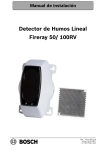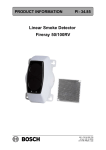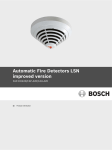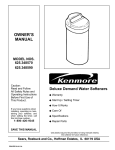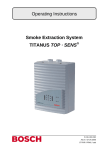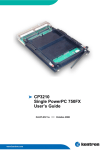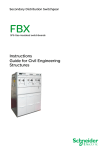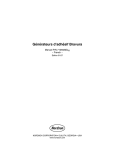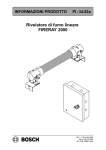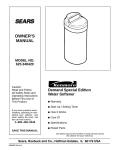Download Bosch Fireray100RV Technical data
Transcript
Installation Instructions Linear Smoke Detector Fireray 50/100RV Table of Contents 1. Mounting Tips . . . . . . . . . . . . . . . . . . . . . . . . . . . . . . . . . . . . . . . . . . . . . 2 1.1. Connections and DIP switch settings . . . . . . . . . . . . . . . . . . . . . . . . . . . . . . . . . . . 3 1.2. Mounting the Fireray 50/100RV . . . . . . . . . . . . . . . . . . . . . . . . . . . . . . . . . . . . . . . . 4 1.3. Mounting the prism reflector . . . . . . . . . . . . . . . . . . . . . . . . . . . . . . . . . . . . . . . . . . 4 1.4. Connection . . . . . . . . . . . . . . . . . . . . . . . . . . . . . . . . . . . . . . . . . . . . . . . . . . . . . . . . . . 5 2. Start-Up . . . . . . . . . . . . . . . . . . . . . . . . . . . . . . . . . . . . . . . . . . . . . . . . . . 7 2.1. Setting up the detector . . . . . . . . . . . . . . . . . . . . . . . . . . . . . . . . . . . . . . . . . . . . . . . 7 2.2. Aligning the detector . . . . . . . . . . . . . . . . . . . . . . . . . . . . . . . . . . . . . . . . . . . . . . . . . . 7 2.3. System test . . . . . . . . . . . . . . . . . . . . . . . . . . . . . . . . . . . . . . . . . . . . . . . . . . . . . . . . . 9 3. Tips on Maintenance and Service . . . . . . . . . . . . . . . . . . . . . . . . . . . 9 4. Technical Data . . . . . . . . . . . . . . . . . . . . . . . . . . . . . . . . . . . . . . . . . . . . . 10 5. Additional Documentation . . . . . . . . . . . . . . . . . . . . . . . . . . . . . . . . . . 10 6. Appendices . . . . . . . . . . . . . . . . . . . . . . . . . . . . . . . . . . . . . . . . . . . . . . . 11 6.1. Installation protocol . . . . . . . . . . . . . . . . . . . . . . . . . . . . . . . . . . . . . . . . . . . . . . . . . . . 11 6.2. Fault diagnosis . . . . . . . . . . . . . . . . . . . . . . . . . . . . . . . . . . . . . . . . . . . . . . . . . . . . . . 12 6.3. Notes . . . . . . . . . . . . . . . . . . . . . . . . . . . . . . . . . . . . . . . . . . . . . . . . . . . . . . . . . . . . . . . 13 Page 1 of 14 610-F.01U.002.706 / A2.en ST/PMF/zab Installation Instructions Mounting Tips Usually, the detector and the reflector are installed at the same height and oriented towards each other. The relatively broad angle of the IR beam eases adjustment and guarantees reliable long- term stability. The mounting surface for the detector must be firm and vibration- free. Metal supports that can be influenced by heat or cold are not suitable for installation. The detector must be installed such that sunlight and artificial light do not beam directly into the detector’s lenses. Normal environmental light conditions have no effect on the IR beam and the evaluation. Mount the reflector on a solid surface at the permissible distance. Ensure that the light beam meets the reflector on the vertical. The reflectors must not be mounted on reflective surfaces such as glass or plain sheet surfaces. Additional reflections lead to malfunctions. For protection against radio interference, use a shielded cable. When you are installing the cable, possible sources of disturbance must be circumvented and the cable must be protected against mechanical damage. A 6 DA mini distributor (product ID 2.798.400.302) is required for wiring. There must be a free visual line between the detector and reflector. The IR light beam must not be blocked by moved objects! 120 mm Detector baseplate Operating mode switch Receiver window Gimbal bearing 210 mm 1. Linear Smoke Detector Fireray 50/100RV Transmitter window Knurled screw for horizontal adjustment (on right of detector) Operating indicator LEDs Knurled screw for vertical adjustment Detector cover Fig. 1.: Detector side view Page 2 of 14 610-F.01U.002.706 / A2.en ST/PMF/zab Installation Instructions Linear Smoke Detector Fireray 50/100RV 1.1. Connections and DIP switch settings on Mounting slots off DIP switch Operating mode switch Plug connector 2-pin output for key switch (optional) Fig. 2.: Reverse side of detector with plug connector, operating mode switch and DIP switch DIP switch The DIP switches can be accessed through the round recess in the detector base plate. Table 1.: Functions of the DIP switch settings * X X Function DIP switch settings 1 2 3 4 50% threshold X X OFF OFF 35% threshold X X OFF ON 25% threshold X X ON OFF 12% threshold (extremely sensitive, only for special applications!) X X ON ON Alarm relay saves the alarm OFF X X X Automatic reset 5 s after the end of the alarm criterion ON X X X Alarm relay after end of readjustment X OFF X X Fault relay at end of readjustment, no alarm X ON X X The factory presets are shaded in gray. * The recommended settings for connection to a fire panel are marked with X. Use DIP switches 3 and 4 to set the required alarm threshold. The factory setting is moderate sensitivity (35%) for normal environmental conditions. Select a threshold of 50% in very dirty environments. Use DIP switch 1 to select the «Save alarm » or «Auto Reset» function (recommended setting for connection to fire panel = «Save alarm »). Page 3 of 14 610-F.01U.002.706 / A2.en ST/PMF/zab Installation Instructions Linear Smoke Detector Fireray 50/100RV Plug connector The plug connector can be accessed through the oval recess on the detector base plate. Table 2.: Pin assignment of the 8- pin connector (from left to right) PIN number Wire color 1 Function Not assigned 2 blue 3 yellow Alarm relay, work contact (NO) 4 red Power supply +10 to +30 V DC 5 black Power supply - 6 green Fault relay, normally closed contact (NC) 7 white Fault relay, center contact (COM) 8 Alarm relay, center contact (COM) Not assigned 1.2. Mounting the Fireray 50/100RV To make mounting easier, you can remove the detector cover by gently raising the upper and lower edges. The mounting slots (see Fig. 2.), which are positioned at a 90angle, enable vertical or horizontal mounting of the detector. Locate the four bore holes at the mounting location using the detector base plate. Observe the planning notes and mounting tips! Check the plug connector and the DIP switch settings (see Section 1.1.). Secure the detector using four screws. Refit the detector cover. If a key switch is required, a two- wire cable should be routed from the detector to the desired location during installation. 1.3. Mounting the prism reflector Select the mounting location in line with the mounting tips (Section 1.). A prism reflector must be used for the Fireray 50RV, and four prism reflectors arranged in a square for the Fireray 100RV. ÌÌÌ ÌÌÌ ÌÌÌ ÌÌÌ Fireray 50RV Fig. 3.: Prism reflectors ÌÌÌÌ ÌÌÌÌ ÌÌÌÌ ÌÌÌÌ ÌÌÌÌ ÌÌÌÌ ÌÌÌÌ ÌÌÌÌ ÌÌÌÌ ÌÌÌÌ ÌÌÌÌ ÌÌÌÌÌÌÌÌ ÌÌÌÌ Fireray 100RV Each reflector is secured using two mounting bores (Ğ 3 mm). Arrange the four reflectors for the Fireray 100RV such that there are no mounting holes in the center (see Fig. 3.). Page 4 of 14 610-F.01U.002.706 / A2.en ST/PMF/zab Installation Instructions Linear Smoke Detector Fireray 50/100RV 1.4. Connection Connection of a Fireray 50/100RV using a NSB100 LSN at the fire panel 1 Bridges Br1, Br2 in position 2-3 2 Contacts in open position NSB 100 LSN I1 NLT1 Configuration for LSN: Parameterize the NSB in the control panel to control output KA1-KA2/KR-R-RR and “Control with Fireray”. VII2 I4 +U LSN II1 NLT2 Br 1 II2 ⊥ on 1 2 3 1 II3 -U DIP switch (recommended setoff Operating mode tings) switch Br 2 II4 +U 1 2 3 III1 III2 FAULT Power supply 10 - 30 V ALARM IV1 RR IV2 R 2 V1 KR COM NC NO COM + - VII1 I3 -U Fireray 50/100 RV Output for key switch (optional) SA SB I2 ⊥ V2 KA1 V3 KA2 RE 3K3 680 Ω VI1 VI2 UEB gn rd bl UEA wh blk ye Operating mode switches: Prism Targeting Alignment Mode Operating Mode 6 DA mini distributor -U +U -U DIP switch: Functions, see table 1. (page 3) I3 +U I4 NSB 100 (if voltage drop < 6 V) EV 24 V - 24 V (if voltage drop > 6 V) Select the following DIP switch settings for connection to a fire panel (see table 1. on page 3): - «Alarm relay saves the alarm» - «Fault relay at end of readjustment, no alarm». Page 5 of 14 610-F.01U.002.706 / A2.en ST/PMF/zab Installation Instructions Linear Smoke Detector Fireray 50/100RV Connection of two Fireray 50/100RV to fire panel with cross zoning via an NBK 100 LSN and two NSB100 LSNs 1 Bridges Br1, Br2 on the NSB 100 in position 2-3 (see connection of one Fireray 50/100RV) 2 Contacts in open position Configuration for LSN: Parameterize the NSB in the control panel to control output KA1-KA2/KR-R-RR and “Control with Fireray”. Observe assignment to detector groups/detectors (see example). NBK 100 LSN Fireray 50/100 RV Parameterize, e.g. to 127/1 VI1 DIP switch (recommended Operating mode settings) switch VI2 V1 V2 500/1 cross zoning with 150, Line 2 current trigger criterion 2 COM NC - + NO COM 3k92 820 bl FAULT Power supply 10 - 30 V ALARM Output for key switch (optional) 150/1 cross zoning with 500, Line 1 current trigger criterion ye rd blk gn NSB 100 LSN wh Parameterize, e.g. to 127/2 V1 KR V2 KA1 Parameterize, e.g. to V3 KA2 KA1-KA2-KR-150/2 6 DA mini distributor 1 Fireray 50/100 RV DIP switch (recommended Operating mode settings) switch NSB 100 LSN Parameterize, e.g. to 127/3 2 V2 KA1 Parameterize, e.g. to V3 KA2 KA1-KA2-KR-500/2 COM NC 1 3k92 820 rd ye - + NO COM bl FAULT Power supply 10 - 30 V ALARM Output for key switch (optional) V1 KR blk gn wh 6 DA mini distributor -U +U -U I3 +U I4 NSB 100 (if voltage drop < 6 V) Page 6 of 14 EV 24 V - 24 V 610-F.01U.002.706 / A2.en ST/PMF/zab Installation Instructions 2. Linear Smoke Detector Fireray 50/100RV Start- Up 2.1. Setting up the detector Start the «Prism Targeting»mode by moving the operating mode switch (see Fig. 2.) up (if the detector is mounted vertically) or to the right (if the detector is mounted horizontally). Connect the power supply. The detector runs in initialization mode for approx. 5 s. The red LED flashes if the detector is operational: 1 x for Fireray 50RV, 2 x for Fireray 100RV. Now direct the detector at the prism, using the two knurled screws, until optimum adjustment is confirmed by a steady yellow LED light. The following LED displays support detector set- up: Yellow LED display Detector status in «Prism Targeting» operating mode off No signal at receiver Flashes -> Flashing frequency increasing Signal is received -> The faster the flashing, the stronger the signal! Steady light Optimum alignment achieved The signal must only move from the reflector to the receiver, under no circumstances must it move to other light sources or reflective surfaces! Cover the prism reflector with a non-reflective material to check. The LED must not be lit. If the yellow LED does not go out, this indicates that a reflector is incorrectly aligned. 2.2. Calibrating the detector Once the optimum detector set- up has been achieved, set the operating mode switch to the center position without displacing the detector. The detector is now in («Alignment Mode»). The detector runs through an automatic configuration procedure to optimize the transmission power and the receiver sensitivity. The following detector statuses may be displayed by the LEDs during this procedure: LED displays Detector statuses in «Alignment Mode» Flashing red Receiver input signal too strong, the transmission power will be reduced. Wait until the LED goes out (max. 20 s). Steady yellow light No signal is being received. Switch back to «Prism Targeting» mode and repeat the detector set-up. Flashing yellow The receiver is receiving a weak signal, the transmission power will automatically be increased. off Transmission power and receiver gain are optimum. Flashing red and yellow Automatic calibration in progress. Page 7 of 14 610-F.01U.002.706 / A2.en ST/PMF/zab Installation Instructions Linear Smoke Detector Fireray 50/100RV Follow the flow chart to perform the calibration process: Switch center Alignment Mode Yellow LED lights up for approx. 5 s No signal: back to detector set -up (Section 2.1.) Steady Wait until both LEDs have stopped flashing yellow LED Turn the knurled screws in one direction and monitor the LED status yellow LED Which LED lights up? red LED Stop turning the knurled screw and wait until the red LED stops flashing Turn the knurled screw slowly in the same direction Turn the knurled screw in the other direction yellow LED Which LED lights up? red LED No LED Repeat the procedure for the other detector axis with the second knurled screw no Both axes adjusted? Do not turn the knurled screw any further y e Check optimum setting: s Yellow LED lights up: 1. With gentle pressure from top/bottom/left/right on the detector housing. 2. Each time the knurled screws are moved. Exit the Alignment Mode Switch at bottom: Operating Mode Page 8 of 14 610-F.01U.002.706 / A2.en ST/PMF/zab Installation Instructions Linear Smoke Detector Fireray 50/100RV When the calibration procedure is complete, move the operating mode switch to the bottom (if the detector is mounted vertically) or to the left (if the detector is mounted horizontally). The detector is now in «Operating Mode». The detector runs a calibration test for approx. 60 s. If the yellow LED lights up as a steady light after the test, you must repeat the detector alignment and calibration procedures (see Sections 2.1. and 2.2.). If a detector alarm is reset in normal mode by a disruption of the power supply, the detector automatically runs a calibration test. If the test is failed, the detector remains in the alarm position. If the test is positive, the yellow LED goes out, the fault relay is reset and the detector is returned to normal mode. In normal mode, the yellow LED flashes every 10 s. 2.3. System test The «Alarm» and «Malfunction» functions must be checked before final start - up. Alarm test Hold the test filter in front of the receiver lens (upper or right- hand part of detector). Select a volume of smoke slightly greater than the threshold set for the detector (see Section 1.1.). Make sure that you do not also cover the transmitter -lens. After approx.10 s, the red LED must light up and the alarm relay must close. With the «Save alarm » detector setting (DIP switch 1 «off»), there must be a reset at the control panel or the power supply must be disrupted for at least 5 s. With the setting «Auto Reset» setting (DIP switch 1 «on»), the alarm is reset automatically if the volume of smoke falls below the selected alarm threshold for at least 5 s. Fault test Cover the reflector with a non- reflective material. After approx. 10 s, the yellow LED must light up and the fault relay must open. As soon as the obstruction is removed, the detector returns to normal mode automatically after approx. 2 s. 3. Tips on Maintenance and Service For maintenance and inspection work on danger detector systems, in Germany the regulations of DIN VDE 0833 apply, which refer to the maintenance interval according to the manufacturer’s instructions. Bosch ST recommends a functional and visual inspection at least once a year. Maintenance and inspection work should be carried out regularly and by trained personnel. Page 9 of 14 610-F.01U.002.706 / A2.en ST/PMF/zab Installation Instructions 4. Linear Smoke Detector Fireray 50/100RV Technical Data Operating voltage 10 V DC . . . 30 V DC Current consumption: - in standby mode - in alarm/malfunction < 4 mA @ 24 V < 15 mA Reset control by power disruption Alarm relay Fault relay Permissible distance between Fireray and the reflector: - Fireray 50RV - Fireray 100RV Optical wavelength 5 m to 50 m 50 m to 100m 880 nm Adjustable alarm threshold values 2.50 dB (25%) 3.74 dB (35%) 6.02 dB (55%) Detector $0.8 Prism reflector $5.0 Axial deviation tolerance (at 35% sensitivity) Operating temperature - 30C . . . +55C Protection type IP 50 Dimensions (W x H x D) 126 x 210 x 120 mm Weight 670 g Housing: - Color - Material light gray/black ABS, non- flammable VdS ID number 5. >5s Normally open; dry contact (2 A @ 30 V DC) Normally close; dry contact (2 A @ 30 V DC) G 203070 Additional Documentation For those with access authorization, on the Bosch ST ExtraNet at www.boschbest.de the current information for each product, as well as the installation instructions supplied with the device, are available for download as a PDF file. Page 10 of 14 610-F.01U.002.706 / A2.en ST/PMF/zab Installation Instructions 6. Linear Smoke Detector Fireray 50/100RV Appendices 6.1. Installation protocol Installation company: Type of object: Installation location: Installation date: Total number of all linear detectors: Detector version: Detector – reflector distance: _________ m Distance of the detector axes to one another _________ m Mounting height _________ m Fireray 50RV Fireray 100RV Mounting surface (e.g. masonry/reinforced concrete/steel beams/wood/etc.) Serial number(s) Reflector size: Supply voltage: _________ V Correct mechanical adjustment of transmitter (when gentle pressure is applied to the detector housing from the left/right/top/ bottom, the yellow LED lights up initially): yes no Alarm triggered with absorption film 35% - 50% tested: yes no Fault triggered by disruption of IR beam tested: yes no 1 x (10 x 10 cm) 4 x (20 x 20 cm) DIP switch settings: 1 2 3 4 on off Comments (environmental conditions, e.g. dust, humidity, temperature etc.) Installation tested on: ____________ by: __________________________ Page 11 of 14 610-F.01U.002.706 / A2.en ST/PMF/zab Installation Instructions Linear Smoke Detector Fireray 50/100RV 6.2. Fault diagnosis Fault indicator Fault LED illuminated permanently Possible cause Action Beam path blocked by an obstacle Check and/or ensure free visual line in the area between the detector and the reflector. Reflector is contaminated/covered/ has fallen down. Check the status of the reflector and clean it if necessary. Supply voltage too low. Measure supply voltage directly at detector. Mode sliding switch in upper position («Direct») Set the switch to «Operation» and wait until the 60 s activation routine is complete. Detector set-up changed on switching to «Operation». When operating the sliding switch following the correct adjustment, make sure that the setting is not changed. The limit of automatic gain control has Clean detector lens and reflector and been reached correct mechanical adjustment! Fault LED flashes Alarm LED illuminated permanently No fault message when IR beam is disrupted Alarm triggered when IR beam is disrupted Triggering of false alarms «MODE Switch» sliding switch in up- Align detector vertically and horizontally until the fault LED is permanently per position («Direct») and incomplete detector set-up illuminated. Then continue using fine adjustment (switch in center position)! DIP switch 1 at OFF («Save alarm »), the alarm display remains saved Reset the detector by disrupting the supply voltage for at least 5 s or select «Reset» on the fire panel Beam path (partially) blocked by an obstacle Ensure a free visual line in the area between the detector and the reflector! Detector receives partial IR signal, e.g. via reflective surfaces near the beam axis. Cover reflector with a dark material to test! Check detector’s range of vision for reflective objects! An object placed in the beam path for testing has acted as the reflector. For testing, use a non-reflective material, maintain a greater distance to the detector, cover the reflector as directly as possible. Sensitivity to existing environmental conditions set too high Select a less sensitive alarm threshold (DIP switches 3 and 4): normal= 35%, less sensitive= 50% Page 12 of 14 610-F.01U.002.706 / A2.en ST/PMF/zab Installation Instructions Linear Smoke Detector Fireray 50/100RV 6.3. Notes __________________________________________________________________ __________________________________________________________________ __________________________________________________________________ __________________________________________________________________ __________________________________________________________________ __________________________________________________________________ __________________________________________________________________ __________________________________________________________________ __________________________________________________________________ __________________________________________________________________ __________________________________________________________________ __________________________________________________________________ __________________________________________________________________ __________________________________________________________________ __________________________________________________________________ __________________________________________________________________ __________________________________________________________________ __________________________________________________________________ __________________________________________________________________ __________________________________________________________________ __________________________________________________________________ Page 13 of 14 610-F.01U.002.706 / A2.en ST/PMF/zab Bosch Security Systems Robert -Koch -Str. 100 D-85521 Ottobrunn Info -Service Telephone: +49 89 6290 - 1039 Fax: +49 89 6290 - 1039 www.bosch -sicherheitssysteme.de [email protected]














